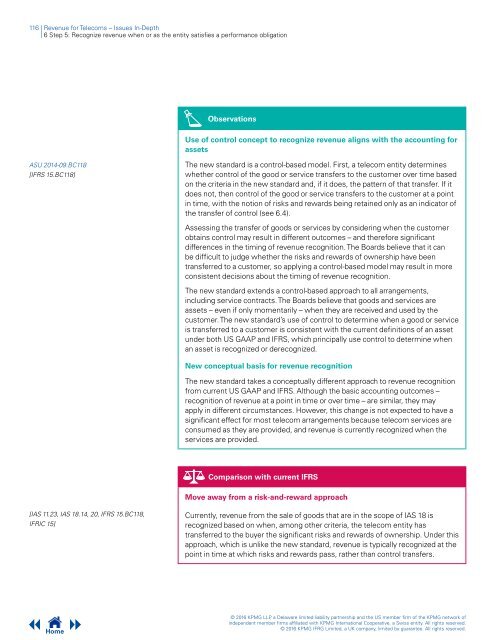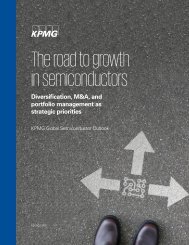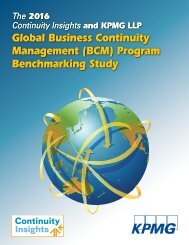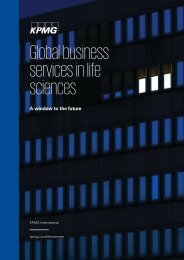Revenue for Telecoms
2cdncba
2cdncba
You also want an ePaper? Increase the reach of your titles
YUMPU automatically turns print PDFs into web optimized ePapers that Google loves.
116 | <strong>Revenue</strong> <strong>for</strong> <strong>Telecoms</strong> – Issues In-Depth<br />
| 6 Step 5: Recognize revenue when or as the entity satisfies a per<strong>for</strong>mance obligation<br />
Observations<br />
Use of control concept to recognize revenue aligns with the accounting <strong>for</strong><br />
assets<br />
ASU 2014-09.BC118<br />
[IFRS 15.BC118]<br />
The new standard is a control-based model. First, a telecom entity determines<br />
whether control of the good or service transfers to the customer over time based<br />
on the criteria in the new standard and, if it does, the pattern of that transfer. If it<br />
does not, then control of the good or service transfers to the customer at a point<br />
in time, with the notion of risks and rewards being retained only as an indicator of<br />
the transfer of control (see 6.4).<br />
Assessing the transfer of goods or services by considering when the customer<br />
obtains control may result in different outcomes – and there<strong>for</strong>e significant<br />
differences in the timing of revenue recognition. The Boards believe that it can<br />
be difficult to judge whether the risks and rewards of ownership have been<br />
transferred to a customer, so applying a control-based model may result in more<br />
consistent decisions about the timing of revenue recognition.<br />
The new standard extends a control-based approach to all arrangements,<br />
including service contracts. The Boards believe that goods and services are<br />
assets – even if only momentarily – when they are received and used by the<br />
customer. The new standard’s use of control to determine when a good or service<br />
is transferred to a customer is consistent with the current definitions of an asset<br />
under both US GAAP and IFRS, which principally use control to determine when<br />
an asset is recognized or derecognized.<br />
New conceptual basis <strong>for</strong> revenue recognition<br />
The new standard takes a conceptually different approach to revenue recognition<br />
from current US GAAP and IFRS. Although the basic accounting outcomes –<br />
recognition of revenue at a point in time or over time – are similar, they may<br />
apply in different circumstances. However, this change is not expected to have a<br />
significant effect <strong>for</strong> most telecom arrangements because telecom services are<br />
consumed as they are provided, and revenue is currently recognized when the<br />
services are provided.<br />
Comparison with current IFRS<br />
Move away from a risk-and-reward approach<br />
[IAS 11.23, IAS 18.14, 20, IFRS 15.BC118,<br />
IFRIC 15]<br />
Currently, revenue from the sale of goods that are in the scope of IAS 18 is<br />
recognized based on when, among other criteria, the telecom entity has<br />
transferred to the buyer the significant risks and rewards of ownership. Under this<br />
approach, which is unlike the new standard, revenue is typically recognized at the<br />
point in time at which risks and rewards pass, rather than control transfers.<br />
Home<br />
© 2016 KPMG LLP, a Delaware limited liability partnership and the US member firm of the KPMG network of<br />
independent member firms affiliated with KPMG International Cooperative, a Swiss entity. All rights reserved.<br />
© 2016 KPMG IFRG Limited, a UK company, limited by guarantee. All rights reserved.







